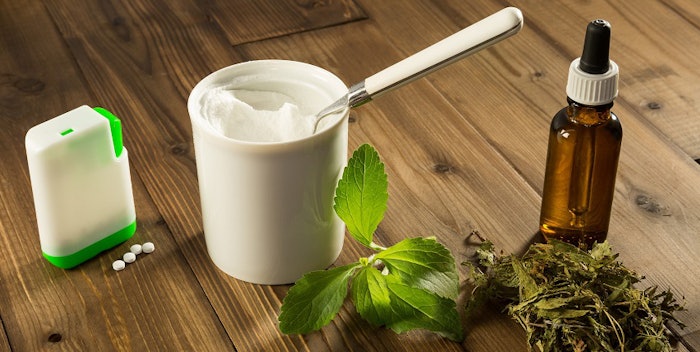
Driven by strong consumer demand for natural, sweet flavors in food and beverages, the stevia market is projected to have a global growth spurt over the next five years.
Research firm MarketsandMarkets expects the stevia market to grow at a compound annual growth rate, or CAGR, of 9.5 percent from 2017 to reach $771.5 million globally by 2022.
“The key drivers for the market’s growth are changes in consumer lifestyles, preferences for zero-calorie beverages, and an increase in demand for natural sugar alternatives,” according to Aslam Shaikh, MarketsandMarkets senior analyst, food, beverage and agriculture.
Also, “growth in demand for stevia and increase in per capita consumption of beverages incorporating stevia are driving this market,” Shaikh added.
U.S. Market Highly Fragmented, Growing Fast
In the U.S., the stevia market is highly fragmented and is growing at a fast pace, notably due to high-quality natural ingredients and specialization of stevia products to meet the changing consumer demands for wellness, according to MarketsandMarkets research.
Meanwhile, increased demand for tabletop sweeteners in developed European countries such as Germany, the U.K., and France, has, in turn, increased the demand for stevia. Based on application, the tabletop sweeteners segment is projected to progress at the highest CAGR during the forecast period of 2017 to 2022, the research firm forecasted.
The U.S. and Japan accounted for the two major stevia consumers globally in 2016.
Stevia’s Sought-after in Asia Pacific
On a regional basis, stevia powders and whole leaf extracts used in the food and beverage industry are in particularly high demand in developing Asia-Pacific markets.
Asia-Pacific accounted for the largest share in the global stevia market in 2016, according to MarketsandMarkets research, and is expected to grow at the highest CAGR, in terms of both value and volume, from 2017 to 2022.
“The increase in demand for healthier, innovative products, and sugar alternatives is driving the growth for stevia in the emerging markets of the Asia-Pacific, South America, and the Middle East,” Shaikh said.
Urbanization and the changes in dietary styles influence the market for stevia-based products in the Asia-Pacific region, in particular. Japan accounted for the largest country-wise market share in the Asia-Pacific region in 2016, followed by China. The U.S. and Japan accounted for the two major stevia consumers globally in 2016, according to MarketsandMarkets research.
On the basis of extract type, the global whole leaf extract segment is projected to grow at the highest CAGR during the forecast period, MarketsandMarkets forecasted. Although the U.S. Food and Drug Administration recognizes the generally recognized as safe (GRAS) status of certain high-purity steviol glycosides (like rebaudioside A), it should be noted that whole stevia leaf and crude stevia extracts are not considered GRAS; therefore, they do not have FDA approval for use in food.










